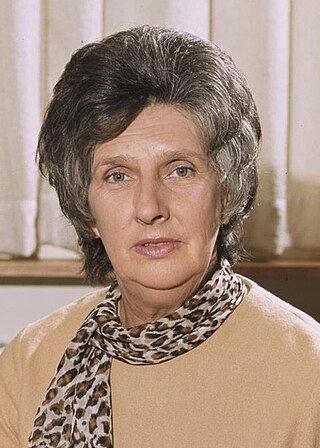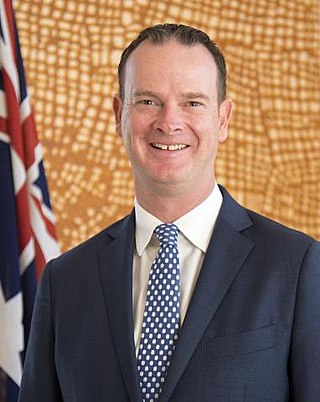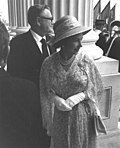
Edward Gough Whitlam was the 21st prime minister of Australia, serving from 1972 to 1975. He held office as the leader of the Australian Labor Party (ALP), of which he was the longest-serving. He was notable for being the head of a reformist and socially progressive administration that ended with his removal as prime minister after controversially being dismissed by the governor-general of Australia, Sir John Kerr, at the climax of the 1975 constitutional crisis. Whitlam is the only Australian prime minister to have been removed from office by the governor-general.

The governor-general of Australia is the representative of the monarch of Australia, currently King Charles III, and performs many constitutional, ceremonial and community roles in the Australian political system. When performing these roles, the governor-general acts independently and is not the King's delegate or agent. The current governor-general is David Hurley, having been appointed on 1 July 2019.

The 1975 Australian constitutional crisis, also known simply as the Dismissal, culminated on 11 November 1975 with the dismissal from office of the prime minister, Gough Whitlam of the Australian Labor Party (ALP), by Sir John Kerr, the Governor-General who then commissioned the leader of the Opposition, Malcolm Fraser of the Liberal Party, as prime minister. It has been described as the greatest political and constitutional crisis in Australian history.

Sir John Robert Kerr, was an Australian barrister and judge who served as the 18th governor-general of Australia, in office from 1974 to 1977. He is primarily known for his involvement in the 1975 constitutional crisis, which culminated in his decision to dismiss the incumbent prime minister Gough Whitlam and appoint Malcolm Fraser as his replacement, which led to unprecedented actions in Australian federal politics.

Sir Garfield Edward John Barwick was an Australian judge who was the seventh and longest serving Chief Justice of Australia, in office from 1964 to 1981. He had earlier been a Liberal Party politician, serving as a minister in the Menzies government from 1958 to 1964.
Sir David Iser Smith was an Australian public servant. He was the Official Secretary to the Governor-General of Australia between 1973 and 1990, in which capacity he served Sir Paul Hasluck, Sir John Kerr, Sir Zelman Cowen, Sir Ninian Stephen and Bill Hayden.

Sir Anthony Frank MasonHonFAIB DistFRSN is an Australian judge who served as the ninth Chief Justice of Australia, in office from 1987 to 1995. He was first appointed to the High Court in 1972, having previously served on the Supreme Court of New South Wales.
Security of tenure is a term with multiple meanings according to jurisdiction. In Australia, it is used in political science to describe a constitutional or legal guarantee that a political office-holder cannot be removed from office except in exceptional and specified circumstances.

The Whitlam government was the federal executive government of Australia led by Prime Minister Gough Whitlam of the Australian Labor Party. The government commenced when Labor defeated the McMahon government at the 1972 federal election, ending a record 23 years of continuous Coalition government. It was terminated by Governor-General Sir John Kerr following the 1975 constitutional crisis and was succeeded by the Fraser government—the sole occasion in Australian history when an elected federal government was dismissed by the head of state.

Margaret Elaine Whitlam, AO was an Australian social campaigner, author, and athlete. She was the wife of Gough Whitlam, the 21st Prime Minister of Australia from 1972 to 1975, and a representative of Australia in swimming at the 1938 British Empire Games in Sydney.

The 1977 Australian federal election was held in Australia on 10 December 1977. All 124 seats in the House of Representatives and 34 of the 64 seats in the Senate were up for election.

Gordon Glen Denton Scholes AO was an Australian politician. He was a member of the Australian Labor Party (ALP) and served in the House of Representatives from 1967 to 1993, representing the Division of Corio. He served terms as Speaker of the House of Representatives (1975–1976), Minister for Defence (1983–1984), and Minister for Territories (1984–1987).
Australia is a constitutional monarchy whose Sovereign also serves as Monarch of the United Kingdom, New Zealand, Canada and eleven other former dependencies of the United Kingdom including Papua New Guinea, which was formerly a dependency of Australia. These countries operate as independent nations, and are known as Commonwealth realms. The history of the Australian monarchy has involved a shifting relationship with both the monarch and also the British government.

The official secretary to the governor-general of Australia and staff provide support to the governor-general of Australia to enable the governor-general to carry out their constitutional, statutory, ceremonial and public duties. Until 1903, the governor-general’s private secretary provided the support to the governor-general, when the official secretary position was established. The position was abolished in 1928 after the Parliament moved from Melbourne to Canberra, but was recreated in 1931. The position was established by statute in its current form in 1984. Since 18 August 2018 the official secretary has been Paul Singer.
Anne, Lady Kerr was the second wife of Sir John Kerr, Governor-General of Australia (1974–1977). They were married in 1975 during his term of office, six months after the death of his first wife Alison.

Jennifer Jane Hocking is an Australian historian, political scientist and biographer. She is the inaugural Distinguished Whitlam Fellow with the Whitlam Institute at Western Sydney University, Emeritus Professor at Monash University, and former Director of the National Centre for Australian Studies at Monash University. Her work is in two key areas, counter-terrorism and Australian political biography. In both areas she explores Australian democratic practice, the relationship between the arms of government, and aspects of Australian political history. Her research into the life of former Australian prime minister Gough Whitlam uncovered significant new material on the role of High Court justice Sir Anthony Mason in the dismissal of the Whitlam government. This has been described as "a discovery of historical importance". Since 2001 Hocking has been a member of the Board of Trustees of the Lionel Murphy Foundation.
Antony Philip Whitlam is an Australian lawyer who has been a politician and judge. He is the son of Gough Whitlam and Margaret Whitlam.

The chief justice of Australia is the presiding justice of the High Court of Australia and the highest-ranking judicial officer in the Commonwealth of Australia. The incumbent is Stephen Gageler, since 6 November 2023.
Sir Maurice Hearne Byers was a noted Australian jurist and constitutional expert. He was the Commonwealth Solicitor-General from 1973 to 1983, in which capacity he played a role in the Gair Affair and the 1975 Australian constitutional crisis. He had an unmatched record of success in his appearances before the High Court of Australia, and he has been characterised as the finest lawyer never to have been appointed to the High Court.
CIA involvement in the Whitlam dismissal is an allegation that the U.S. Central Intelligence Agency (CIA) was involved in the 1975 Australian constitutional crisis, which culminated in the dismissal of Prime Minister Gough Whitlam.

















